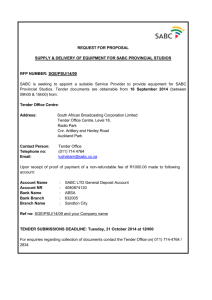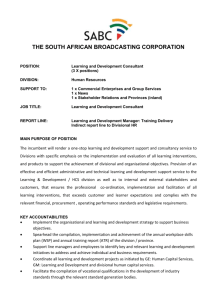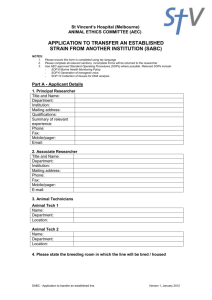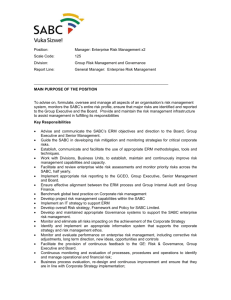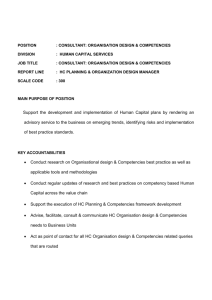High Level Findings: Skills Audit (continue)
advertisement
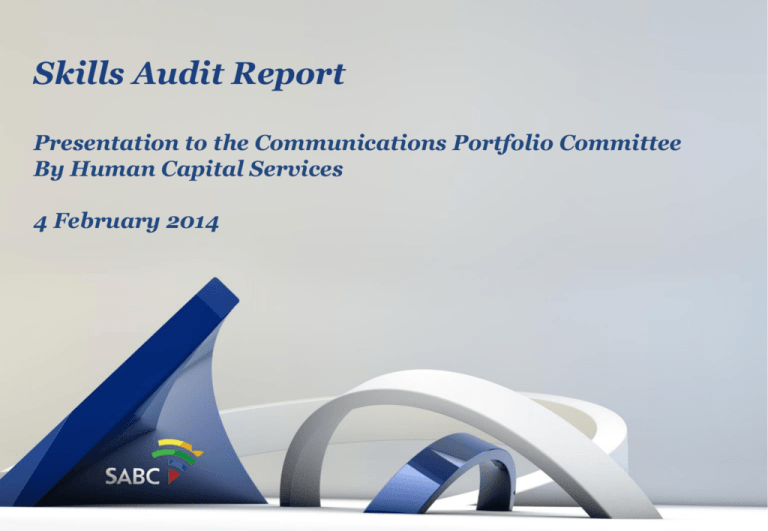
Skills Audit Report Presentation to the Communications Portfolio Committee By Human Capital Services 4 February 2014 Content 1. 2. 3. 4. Background and Context Methodology and Approach High Level Findings and Recommendations – Skills Audit High Level Findings and Recommendations – Qualification Authentication 5. High Level Findings and Recommendations – Executive and Senior Management Competency based Assessments 6. High Level Recommendations and Way Forward 7. Questions PwC/Vutivi and LTS 2 Background and Context PwC 3 Background and Context The South African Broadcasting Corporation (SABC) undertook a Skills Audit project which aims to ensure that the entity is effectively and efficiently aligned in terms of skills and competencies and organisational change. PwC in partnership with Vutivi and LTS was appointed via tender number 7911. This project commenced in April 2013 and was completed in July 2013. The envisaged outcomes of Skills Assessment Project were the following: • • • • • List of critical and scarce skills for the SABC and workforce segment; Development of personal development plans (PDPs); Organisational training plan to address the skills gaps identified for digitisation and current needs; Skills and competency assessment report for the entire organisation; and Qualifications verification report based on current records database. PwC/Vutivi and LTS 4 Background and Context (Cont..) • • • • • • • • • Project Challenges The primary challenge experienced during the Workforce Study and Skills Assessment 2013 project centred on access and integrity of information: • Poor quality and lack of information available in personnel files • Lack of job specifications and associated tasks not standardised • Core business processes not mapped • Reluctance of executive and senior managers to honour scheduled assessment appointments • Lack of and inaccurate job profiles The initial intention in relation to the skills audit was that the scope of the project would cover 180 degree assessment with individuals plus their respective managers’ assessments. The challenge of inaccurate or no job profiles meant that the project team had to validate technical competencies across 444 job families with respective line managers. Given the time constraints, the scope in relation to the skills audit was then limited to 90 degree assessments. The consortium, however, has analysed the outcomes of the selfassessments and have made deductions in relation to the skills requirements of all participating individuals and conclusions do not detract from the quality and depth and breadth of skills findings. PwC/Vutivi and LTS Structure of the Report Executive Summary •The Executive Summary provides background, context and the key objectives of the project. Chapter 1 •Approach and Methodology. Chapter 2 •Detailed Findings: Qualification Authentication. Chapter 3 •Detailed Findings: Executive and Senior Management Competency and Integrity Assessments. Chapter 4 •Detailed Findings: Skills Audit. Concluding Remarks and Way Forward 5 Methodology and Approach PwC 6 Methodology Background and Context (Cont..) The methodology for this Skills Audit was designed and tailored specifically for the SABC environment. Our approach aimed to achieve an organisation wide view, within a limited timeframe and build on recent work addressing the SABC’s skills requirements in the broadcasting industry. In order to provide an organisation wide view required that the SABC be first defined and the definition applied is one which covers the SABC and broadcasting industry segments and identifies the functions which are carried out in the industry. Four parallel streams of work were undertaken to provide a preliminary view of the SABC skills requirements and gaps as well as the critical skills segments that exist within the organisation. Workstream 1. Qualification Authentication Snapshot of our Methodology and Approach As part of the project it was required to authenticate at least a Senior Certificate and one other relevant qualification for all SABC permanent employees to ensure that SABC permanent employees meet the minimum requirements. Determining the authenticity of a qualification is a vital step in the assessment of the individual’s profile pertaining not only to competency but it also provides insight into the candidate’s integrity. 2. Executive and Senior Management Competency and Integrity Assessment PwC/Vutivi and LTS The assessment process was designed to assess the demands placed on SABC Executives and Senior Management in strategic leadership roles within the organisation. Our approach included thoroughly researched competencies and competency models, which has resulted in the development of a comprehensive competency dictionary. Competencies are defined according to their applicability at different organisational levels. The assessment batteries used are registered as Psychological tests with the Health Professions Council of South Africa, and in all instances South African norm groups were used when generating the assessment results. 7 Background and Context (Cont..) Workstream 3. Skills Audit Snapshot of our Methodology and Approach As part of the SABC’s journey to migrate from analogue to digital, a skills audit was initiated to: Identify and verify organisational skills requirements; Identify employee skills levels; and Pinpoint the skills gaps in an effort to address them through various integrated skills development initiatives/interventions. In order to achieve the above, the following three-phased approach was followed: Data Collection, Data Capturing and Data Analysis. PwC/Vutivi and LTS 8 High Level Findings: Skills Audit PwC 9 High Level Findings: Skills Audit Future Requirements 1 High Level Findings Increase in the demand for technical skills Digitisation will increase the technical content of the SABC’s processes, products and services and as a result, the demand for the following technical skills will increase: Expert metadata skills Broadcast/IP network skills Re-versioning and repurposing skills Digital broadcast architecture and digital equipment skills Digital signal distribution skills Ingest skills Post-production of news content Demand for skills to operate and maintain digital equipment and technology Skills will be required to perform the following using digital equipment and technology: Convert content from analogue to digital Compression technologies and skills Playback content in digital format Distribute audio and visual content in digital format to the transmitter station(s) Demand for digital software skills Digital software will require re-skilling and up-skilling in the following areas: Ingest digital files into the SABC archive system Manage digital content Advanced coding techniques Advanced modulation techniques Demand for digital archivist skills Digitisation will have a significant impact on the SABC’s archive system and the ability to archive and retrieve digital content. This will revolutionise the workflows of the SABC. However, since the requirements for the digital archive system have not been established yet, the exact impact cannot be determined at this stage. 2 3 4 PwC/Vutivi and LTS 10 High Level Findings: Skills Audit (continue) Future Requirements 5 High Level Findings Requirements for multi-skilling The SABC will initially require a hybrid of analogue and digital skills while it gradually phases out analogue content. This will demand multi-skilling – individuals will have to understand both analogue and digital platforms and their impact on content development and workflow. Scarce and critical skills need to be addressed through a combination of skills programmes and short courses The following have been selected as the most scarce and critical skills: Communication skills Time management Strategic thinking Broadcast engineering Budgeting skills Creative writing and scripting skills Business management In comparison, the most scarce and critical skills across all subsectors of MICT include sales skills, technical skills, IT and software skills, oral and written communication, customer handling skills, team working skills, problem solving skills, planning and organising skills, and strategic management skills. Strategies such as bursaries, learnerships and especially internships are needed to attract and retain individuals in scarce and critical occupations The following list represents the top twelve scarce occupations in the broadcasting industry in the next two to three years: Author and writer Radio and television journalists Director Camera operator Continuity person Sound technician Radio station operator Accountant and financial manager Broadcast transmitter operator Film and video editor Graphic designer Programme and project manager 6 7 PwC/Vutivi and LTS 11 High Level Findings: Skills Audit (continue) Skills gaps and priorities A skills gap – in the context of this study – is defined as the difference between an employee’s actual level of proficiency and the level of proficiency required in the job, based on benchmarking. The following pending decisions will impact on the skills gaps and priorities in the SABC: • While it is envisaged that the SABC will be launching additional channels, the skills required will be determined by whether the new channels will be prepared/packaged in-house, or whether this function will be outsourced. If the new channels are outsourced, then the jobs and skills will be with the independent sector. The information in this section is based on the assumption that at least two channels – a News and Sport Channel – will be packaged in-house by the SABC. • The SABC’s requirements of the digital archive system will determine how workflows and skills will be impacted. At this stage, these requirements have not been finalised. The stages of content production that will be impacted most by digital broadcasting are Post-production and Distribution. PwC/Vutivi and LTS 12 High Level Findings: Skills Audit (continue) The following table shows how the SABC’s skills levels in Post-production, Distribution and Digital Equipment compare to the MICT benchmark Basic Level Competent Level Advanced Level Expert Level Post-production 10% 18% 36% 37% Distribution 8% 21% 37% 34% Digital Equipment 11% 40% 35% 14% MICT Benchmark 1% 28% 57% 14% • Majority of Post-production and Distribution employees are at an advanced and expert level of proficiency; and • Majority of Digital Equipment employees are at a competent and advanced level of proficiency. Compared to the MICT benchmark: • A higher percentage of employees are at a basic and expert level of proficiency; and • A lower percentage of employees are at an advanced level of proficiency. PwC/Vutivi and LTS 13 High Level Findings: Skills Audit (continue) The following graph indicates the skills gaps in Post-production, Distribution and Digital Equipment Compared to the MICT benchmark, the following skills gaps are present: • Metadata skills • Broadcast/IP network skills • Re-versioning and repurposing skills PwC/Vutivi and LTS 14 High Level Findings: Skills Audit (continue) The following table presents a summary of development needs/priorities in Post-production, Distribution and Digital Equipment The technical skills gaps and priorities as outlined in the skills audit results can be addressed by any of the following types of interventions: • Increased training activity; The breadth and depth of the SABC’s re-skilling and up-skilling will • Increase in trainee programmes; be determined by the scale of its digital transformation, e.g. its has • More performance reviews and feedback; not yet been decided whether new channels will be prepared/packaged • A mentorship programme; in-house. • A change in work practices; We recommend the 70-20-10 principle for skilling of employees – • Better job-matching or deployment; 70% of resources invested in on-the-job training, 20% in coaching/ • Better utilisation of skills; and mentoring and 10% in classroom training. • Increase in recruitment practices. PwC/Vutivi and LTS 15 High Level Findings: Skills Audit Finding Findings of gap analysis Recommendation (Meeting minimum skill requirements) 1 The following scarce and critical skills should be addressed through a combination of skills programmes and short courses: • Communication; • Time management; • Strategic thinking; • Budgeting; • Creative writing and scripting; and • Business management. The most scarce and critical skills are ‘soft skills’, e.g. communication, time management and strategic thinking. Data from the skills audit indicate that participants have generally rated their level of proficiency against these skills – the behavioural competencies – as high, i.e. advanced to expert. 2 The following list represents the top twelve scarce occupations in the broadcasting industry in the next two to three years: • Author and writer • Radio and television journalists • Director • Camera operator • Continuity person • Sound technician • Radio station operator • Financial accountant and manager • Broadcast transmitter operator • Film and video editor • Graphic designer • Programme and project manager PwC/Vutivi and LTS High Low The SABC should implement strategies such as bursaries, learnerships and especially internships to attract and retain individuals in the scarce occupations. 16 High Level Findings: Skills Audit 3 4 The SABC will initially require a hybrid of analogue and digital skills while the SABC gradually phases out analogue content. This will demand multi-skilling – individuals who will have to understand both analogue and digital platforms and their impact on content development and workflow. Digitisation will have a significant impact on the SABC’s archive system and the ability to archive and retrieve digital content. The requirements for the digital archive system have however not been established yet and therefore, the exact impact cannot be determined at this stage. 5 Work flows and processes must enable employees to combine their expertise in their own area with some degree of skilling in other areas and then applying their specialist expertise across those areas in teams. Multi-skilling should be encouraged, but not at the expense of reducing the pool of specialists the SABC has in some disciplines. High Low It is important to finalise the requirements for the SABC’s digital archive system as soon as possible, to ascertain the exact impact on workflow and skills needs in this area. High Low Digitisation will require specific equipment, technology and software, which would impact on skills requirements: • • Digital equipment and technology will be needed to (a) convert content from analogue to digital, (b) playback content in digital format, and (c) distribute audio and visual content in digital format to the transmitter station(s); and Digital software will be required to ingest digital content files into the SABC archive system and to manage digital content. High Low 6 The demand for the following technical skills will increase as a result of the SABC’s migration to digitisation: • Expert metadata skills, so that metadata can be built into the digital content; • Broadcast/IP network skills; • Re-versioning and repurposing skills; • Digital broadcast architecture and digital equipment skills; • Digital signal distribution skills; • Ingest skills; and • Skills in post-production of digital news content. PwC/Vutivi and LTS High Low Digital equipment, technology and specialised software will require the reskilling and up-skilling of people in areas such as: • Compression technologies/skills; • Converting and playback of digital content; • Distribution of digital content; • Advanced coding techniques; and • Advanced modulation techniques. It is important that individuals understand the digital platforms and required skills. The breadth and depth of the SABC’s re-skilling and up-skilling will be determined by the scale of its digital transformation, e.g. it has not yet been decided whether new channels will be prepared/packaged in-house. The technical skills gaps and priorities as outlined in the skills audit results can be addressed by any of the following types of interventions: • Increased training activity; • Increase in trainee programmes; • More performance reviews and feedback; • A mentorship programme; • A change in work practices; • Better job-matching or deployment; • Better utilisation of skills; and • Increase in recruitment practices. We recommend the 70-20-10 principle for skilling of employees – 70% of resources invested in on-the-job training, 20% in coaching/ mentoring and 10% in classroom training. 17 High Level Findings: Qualification Authentication PwC 18 High Level Findings: Qualification Authentication The following summary table provides a concise and high level overview of the findings identified during the authentication process of qualifications for all permanent SABC employees. Red Amber Green Incorrect or irrelevant q ualifica-tion on file 1st Qualification (Senior Certificate) 0 42 101 1 2nd Qualification 0 40 187 3rd Qualification 0 5 21 0 1st Qualification (Senior Certificate) 6 54 155 4 2nd Qualification 1 68 180 3rd Qualification 0 8 2 1st Qualification (Senior Certificate) 18 146 721 19 2nd Qualification 2 184 496 0 3rd Qualification 0 3 5 27 550 1868 Level 100 200 & 300 3643 No personnel file No 1st Qualifica-tion (Senior Certificate) No 2nd Qualification (Tertiary) No 3rd Qualification 350 270 0 515 393 363 600 124 1509 400 Total PwC/Vutivi and LTS 1728 2528 24 124 2252 2361 3643 19 High Level Findings: Qualification Authentication Finding 1 Findings of gap analysis (Meeting minimum Legislative and Best Practice Standards) A total of 1868 (25%) qualifications are authentic. Comply 2 3 4 5 6 124 (3%) employee personnel files could not be produced by the Central Hub and there was no audit trail available to track movement of the file. 242 (6%) Senior Certificates lacked sufficient information or the copy quality resulted in difficulty to verify with the relevant institution. 292 (6.2%) Tertiary Qualifications (1st Degree) lacked sufficient information or the copy quality of the qualification resulted in difficulty to verify authentication with the relevant institution. 24 (1%) had non related qualification on file. e.g.: finance administrator had a diploma for beauty and health on file. 2252 (62%) of the employee personnel files had no proof of a Senior Certificate on file. PwC/Vutivi and LTS Comply Comply Comply Comply Comply Recommendation • Qualification verification should be part of a holistic recruitment process. • The verification of qualifications of all new applicants should be the norm, and integrated in relevant policies and procedure; • Standardisation and alignment of personnel record keeping practices. Employee relations are governed by a variety of legislation, including the Basic Conditions of Employment Act and the Labour Relations Act; • The Basic Conditions of Employment Act No. 75 of 1997 states that various documents relating to employees that should be kept for future purposes. • Concerted efforts required to ensure that standardisation of personnel record keeping practices is implemented within the SABC. • Concerted efforts required to ensure that standardisation of personnel record keeping practices is implemented within the SABC. • Concerted efforts required to ensure that standardisation of personnel record keeping practices is implemented within the SABC. • Concerted efforts to be implemented to ensure that all employee files are updated with certified copies of the minimum required qualifications. NonCompliance NonCompliance NonCompliance NonCompliance NonCompliance NonCompliance 20 High Level Findings: Qualification Authentication 7 8 9 2361 (65%) of the employee personnel files had no proof of a tertiary qualification on file. 24 (1%) fraudulent or non-compliant Senior Certificates and Grade 10 Certificates. Comply Comply Comply 10 Lack of information, outdated information on personnel files, incorrectly filed information not aligned to best practice or legislative requirements for record keeping. PwC/Vutivi and LTS Concerted efforts to be implemented to ensure that all employee files are updated with certified copies of the tertiary qualifications. • The SABC to implement corrective action and commence with further investigations. • The SABC to implement corrective action and commence with further investigations. NonCompliance NonCompliance 3 (0.0008%) fraudulent or non-compliant Tertiary Qualifications. Comply • NonCompliance NonCompliance Concerted efforts required to standardise the record keeping standards for the SABC. This needs to be aligned to legislative requirements and best practice. The automation of record keeping should be considered. Employees’ files should have the following information (extracted from best practice) •Job description for the position; •Job application and/or resume; •Certified copies of qualifications; •Offer of employment; •SARS documentation; •UIF documentation; •Receipt or signed acknowledgment of employee handbook; •Performance evaluations; •Forms relating to employee benefits; •Forms providing next of kin and emergency contacts; •Records of attendance or completion of training programs; •Warnings and/or other disciplinary actions; •Employment contract, written agreement, receipt, or acknowledgment between the employee and the employer; •Documents relating to the employee's departure from the company. 21 High Level Findings: Executive and Senior Management Competency Based Assessments PwC 22 High Level Findings: Executive and Senior Management Competency Based Assessments High Level Findings Executive and Senior Management Competency and Integrity Assessments: The following summary graph provides a concise and high level overview of the findings extracted from the respective results of the Competency and Integrity assessments. The assessment process was designed to assess the demands placed on the SABC’s Executives and Senior Management in strategic leadership roles within the organisation. The results is alarming and indicate that the SABC’s Executive and Senior Management do not meet the minimum competency requirements. Legend Description Does not 11% (7) demonstrated no evidence of the required competency. meet Does not meet + Meets - Meets Meets + Exceeds PwC/Vutivi and LTS 36% (24) The results indicated major developmental needs: the participants demonstrated very limited aspects of competence; high risk factors identified which could inhibit performance. 21% (14) The results indicated significant development needs: participants demonstrated some aspects of competence, but not consistently at the level required for an executive level position; significant risk factors identified which could inhibit performance. 17% (11) The results indicated minor development needs: still some aspects which require enhancement for executive level position, competency not demonstrated at a competent level consistently across all exercises; minor risk factors identified which could inhibit consistent performance. 12% (8) The results indicated that participants met the competency requirements, demonstrates aspects relating to enhanced requirements in some exercises. 3% (2) The results indicated that these participants demonstrate significant areas of strength, exceed competency requirements in all exercises; no risk factors identified which could inhibit performance. 23 High Level Findings: Executive and Senior Management Competency Based Assessments (cont..) Finding 1 2 General findings: The current SABC leadership landscape demonstrates the following areas of Strengths: • Building strategic relationships; • Leading people; • Resilience; • Emotional intelligence; • Accepting responsibility; • Communication. General findings: The current SABC leadership landscape demonstrates the following areas of development: • Strategic thinking; • Problem solving; • Financial management/business acumen; • Change management. Findings of gap analysis * (Exceed/Do not meet the minimum requirements and standards) Exceed Recommendation • The strengths as mentioned can be leveraged to develop accelerated training interventions to address the developmental areas. • Implement a formal mentor and coaching programme for Executives and Senior Managers; We recommend that accelerated leadership development should be one of the priority areas in the SABC training strategy, with prioritised training intervention. Do not Meet • Exceed Do not Meet 3 • Findings: Cognitions and Managing Work • 60% of the group did not meet the minimum requirements for Strategic Thinking at an executive level; • 56% of the group were not able to demonstrate adequate levels in solving problems and making decisions; • a further 15% only demonstrated marginal competence in Strategic Thinking and Problem Solving; • This suggests that the majority of the group applies a reactive approach to solving problems (underdeveloped capacity to anticipate potential challenges), are not likely to consider all possible alternatives (or identify potential risks) or adequately consider long term implications of decisions; • Need to adhere to policies, systems and procedures, rather than creating them as required in period of change; • 35% of the group did not consider the financial information provided in the case study at all. 22% looked at the finances, but only at a superficial level; • 41% did not meet the competency requirements for Change Management. PwC/Vutivi and LTS • • Exceed Do not Meet • • The under-developed cognitive skills of the group present a challenge – particularly as the SABC enters a period of significant change. The Senior Managers and Executives will need to create new systems and processes to guide decision-making. Executive development should be one of the priority areas in the SABC’s training strategy; Concerted efforts are required for effective and measurable performance metrics to be implemented for the Senior Management and Executive Team, to drive performance; The culture at present appears to be reactive. The lower levels of long term and consequential thinking within the team means that there is insufficient focus on anticipating possible problems and implementing measures that will attempt to minimise possible risks. There needs to be more emphasis on PROACTIVE decision-making and long term planning, and holding individuals accountable when this is not done within their sphere of responsibility; We recommend that intense, goal directed coaching should run parallel to the above interventions; The programme implemented should focus on developing the following competencies: • Financial Management and Business Acumen; • Strategic Thinking and Long Term Planning in a business environment; • Problem Solving and Analysis – including risk identification and proactive decision-making; • Change Management; • Managing Performance; • Achieving results. 24 High Level Recommendations and Way Forward PwC 26 Strategy & Leadership High level recommended way forward • Structure • Align Strategy to mandate • Tactical Strategy to support DTT ramp up. • • LONG TERM (18 -36 MONTHS) MEDIUM TERM (6 – 18 MONTHS) SHORT TERM (1 – 6 MONTHS) • Balancing public broadcasting with revenue generation • On the job coaching for Leadership to improve Leadership competency levels. Leadership alignment to strategy, highperforming culture and new ways of working. • Defining what is core • And non core implications of cosourcing and out-sourcing. SABC JOURNEY MAP • Implement Ideal Macro Structure Discuss , agree and approve organisation design principles. • Develop implementation plan for approved organisational structure. • Implement Interim Macro Structure • Training on processes • Performance mngt system,. Workshop the Ideal and Interim Macro Structure and approve. • Standardise, simplify, map, RACI and strengthen internal controls for high value adding processes. Implement effected reward and recognition schemes to foster skills transfer within SABC • All SABC employees to align to the “one-SABCbrand” with in depth understanding of the SABC sub Cultures • Manage non-performance • Workshop and agree process priority areas Process • Standardise, simplify, map, RACI and strengthen internal controls for pressure points. PwC • Establish a SABC Academy for the broadcasting industry to build a talent pipeline. • Define KPI’s to processes and link to performance management system. • Implement workforce accountability towards process and SABC values • Moving from Strategy to execution • Define the SABC talent management strategy and link to dual career pathing • Define and embed SABC values to sustain a high performing culture. • Implement consequence management for not living the SABC values. Talent Culture and Values 114 THANK YOU PwC 28
